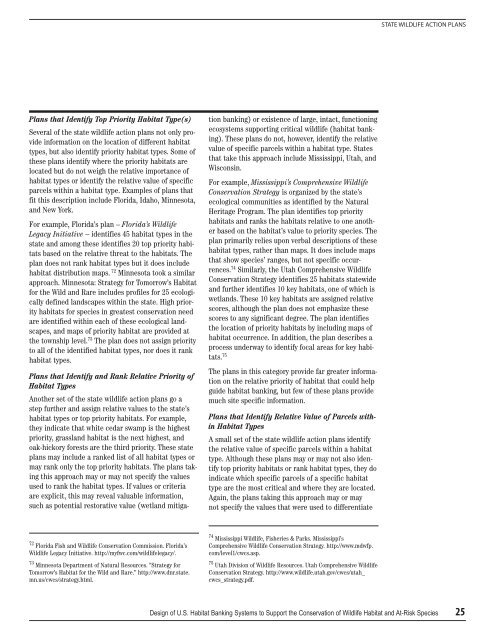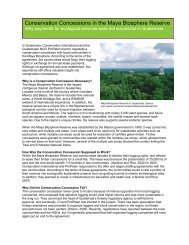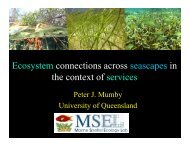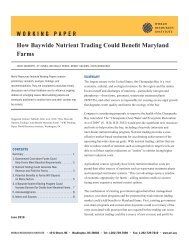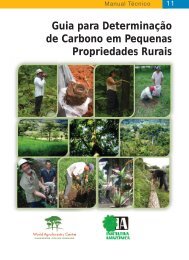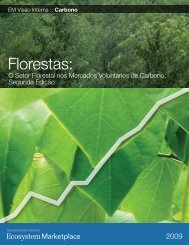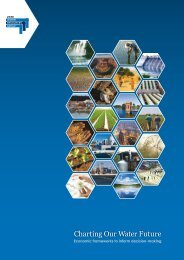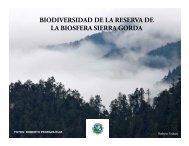Design of US Habitat Banking Systems to Support the Conservation ...
Design of US Habitat Banking Systems to Support the Conservation ...
Design of US Habitat Banking Systems to Support the Conservation ...
Create successful ePaper yourself
Turn your PDF publications into a flip-book with our unique Google optimized e-Paper software.
STATE WILDLIFE ACTION PLANSPlans that Identify Top Priority <strong>Habitat</strong> Type(s)Several <strong>of</strong> <strong>the</strong> state wildlife action plans not only provideinformation on <strong>the</strong> location <strong>of</strong> different habitattypes, but also identify priority habitat types. Some <strong>of</strong><strong>the</strong>se plans identify where <strong>the</strong> priority habitats arelocated but do not weigh <strong>the</strong> relative importance <strong>of</strong>habitat types or identify <strong>the</strong> relative value <strong>of</strong> specificparcels within a habitat type. Examples <strong>of</strong> plans thatfit this description include Florida, Idaho, Minnesota,and New York.For example, Florida’s plan – Florida’s WildlifeLegacy Initiative – identifies 45 habitat types in <strong>the</strong>state and among <strong>the</strong>se identifies 20 <strong>to</strong>p priority habitatsbased on <strong>the</strong> relative threat <strong>to</strong> <strong>the</strong> habitats. Theplan does not rank habitat types but it does includehabitat distribution maps. 72 Minnesota <strong>to</strong>ok a similarapproach. Minnesota: Strategy for Tomorrow’s <strong>Habitat</strong>for <strong>the</strong> Wild and Rare includes pr<strong>of</strong>iles for 25 ecologicallydefined landscapes within <strong>the</strong> state. High priorityhabitats for species in greatest conservation needare identified within each <strong>of</strong> <strong>the</strong>se ecological landscapes,and maps <strong>of</strong> priority habitat are provided at<strong>the</strong> <strong>to</strong>wnship level. 73 The plan does not assign priority<strong>to</strong> all <strong>of</strong> <strong>the</strong> identified habitat types, nor does it rankhabitat types.Plans that Identify and Rank Relative Priority <strong>of</strong><strong>Habitat</strong> TypesAno<strong>the</strong>r set <strong>of</strong> <strong>the</strong> state wildlife action plans go astep fur<strong>the</strong>r and assign relative values <strong>to</strong> <strong>the</strong> state’shabitat types or <strong>to</strong>p priority habitats. For example,<strong>the</strong>y indicate that white cedar swamp is <strong>the</strong> highestpriority, grassland habitat is <strong>the</strong> next highest, andoak-hickory forests are <strong>the</strong> third priority. These stateplans may include a ranked list <strong>of</strong> all habitat types ormay rank only <strong>the</strong> <strong>to</strong>p priority habitats. The plans takingthis approach may or may not specify <strong>the</strong> valuesused <strong>to</strong> rank <strong>the</strong> habitat types. If values or criteriaare explicit, this may reveal valuable information,such as potential res<strong>to</strong>rative value (wetland mitigationbanking) or existence <strong>of</strong> large, intact, functioningecosystems supporting critical wildlife (habitat banking).These plans do not, however, identify <strong>the</strong> relativevalue <strong>of</strong> specific parcels within a habitat type. Statesthat take this approach include Mississippi, Utah, andWisconsin.For example, Mississippi’s Comprehensive Wildlife<strong>Conservation</strong> Strategy is organized by <strong>the</strong> state’secological communities as identified by <strong>the</strong> NaturalHeritage Program. The plan identifies <strong>to</strong>p priorityhabitats and ranks <strong>the</strong> habitats relative <strong>to</strong> one ano<strong>the</strong>rbased on <strong>the</strong> habitat’s value <strong>to</strong> priority species. Theplan primarily relies upon verbal descriptions <strong>of</strong> <strong>the</strong>sehabitat types, ra<strong>the</strong>r than maps. It does include mapsthat show species’ ranges, but not specific occurrences.74 Similarly, <strong>the</strong> Utah Comprehensive Wildlife<strong>Conservation</strong> Strategy identifies 25 habitats statewideand fur<strong>the</strong>r identifies 10 key habitats, one <strong>of</strong> which iswetlands. These 10 key habitats are assigned relativescores, although <strong>the</strong> plan does not emphasize <strong>the</strong>sescores <strong>to</strong> any significant degree. The plan identifies<strong>the</strong> location <strong>of</strong> priority habitats by including maps <strong>of</strong>habitat occurrence. In addition, <strong>the</strong> plan describes aprocess underway <strong>to</strong> identify focal areas for key habitats.75The plans in this category provide far greater informationon <strong>the</strong> relative priority <strong>of</strong> habitat that could helpguide habitat banking, but few <strong>of</strong> <strong>the</strong>se plans providemuch site specific information.Plans that Identify Relative Value <strong>of</strong> Parcels within<strong>Habitat</strong> TypesA small set <strong>of</strong> <strong>the</strong> state wildlife action plans identify<strong>the</strong> relative value <strong>of</strong> specific parcels within a habitattype. Although <strong>the</strong>se plans may or may not also identify<strong>to</strong>p priority habitats or rank habitat types, <strong>the</strong>y doindicate which specific parcels <strong>of</strong> a specific habitattype are <strong>the</strong> most critical and where <strong>the</strong>y are located.Again, <strong>the</strong> plans taking this approach may or maynot specify <strong>the</strong> values that were used <strong>to</strong> differentiate72 Florida Fish and Wildlife <strong>Conservation</strong> Commission. Florida’sWildlife Legacy Initiative. http://myfwc.com/wildlifelegacy/.73 Minnesota Department <strong>of</strong> Natural Resources. ”Strategy forTomorrow’s <strong>Habitat</strong> for <strong>the</strong> Wild and Rare.” http://www.dnr.state.mn.us/cwcs/strategy.html.74 Mississippi Wildlife, Fisheries & Parks. Mississippi’sComprehensive Wildlife <strong>Conservation</strong> Strategy. http://www.mdwfp.com/level1/cwcs.asp.75 Utah Division <strong>of</strong> Wildlife Resources. Utah Comprehensive Wildlife<strong>Conservation</strong> Strategy. http://www.wildlife.utah.gov/cwcs/utah_cwcs_strategy.pdf.<strong>Design</strong> <strong>of</strong> U.S. <strong>Habitat</strong> <strong>Banking</strong> <strong>Systems</strong> <strong>to</strong> <strong>Support</strong> <strong>the</strong> <strong>Conservation</strong> <strong>of</strong> Wildlife <strong>Habitat</strong> and At-Risk Species 25


